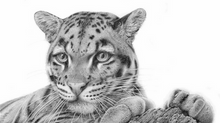The Survivor
- Jon Isaacs
- Jun 27, 2024
- 4 min read
‘How lady luck had smiled on me’, by Jon Isaacs.
I used to think I knew which species were “Big” cats, but now I’m not so sure. I always assumed it depended upon size and that it included lion, tiger, jaguar, leopard, snow leopard, cheetah and cougar. Then I read that it depends upon which cats can roar so that knocks out the cheetah, puma and snow leopard. Apparently, whilst the cheetah and puma chirrup and purr they are lacking a specialized larynx and hyoid apparatus which would allow them to roar. They therefore form a separate genus. All the others fit within the genus Panthera although the snow leopards can’t roar like the others. This could be because of modifications to their breathing system caused by adaptation to a colder and more rarified atmosphere.
Of the species mentioned, most have become popular amongst wildlife fans for their beauty, power and charisma. But one of them has, until recently, existed quietly, successfully and out of the spotlight. Welcome to the world of a very cool cat, the cougar, puma or mountain lion. Even the names are impressive and cause confusion. The cat is called puma in South America and cougar or mountain lion in North America
The cougar has been around for a long time. Fossils show that many species of North America’s early mammals, including the Mountain lion, were wiped out by a catastrophic extinction event which struck in the distant past. It was only a matter of time however before the puma from South America moved north to again colonise North America. Of all mammal species, they have the greatest distribution area, stretching from Chile in the South to Canada in the North. The vast majority of the cats are to be found on the western sides of the continents although the Florida puma, the rarest of the sub species, clings on in the everglades of Florida on the east coast.
The cougar is a secretive cat which is generally a loner. However, recently in Patagonia, there has been evidence of as many as seven, working as a coalition, to bring down prey. The Puma’s colour varies depending on where it lives. In the tropics it is often a rich brown whilst in more temperate climates it is often grey. In size, the largest tend to be found in Canada and are capable of bringing down large ungulates like elk whilst the smallest tend to reside in areas like the Pantanal, Brazil and feed on smaller mammals, birds and reptiles. They avoid prey competition with Jaguars which are far stronger and would kill a puma if given the chance.
The cougar is expanding its range despite coming into increasing contact with an expanding human population. In South America there are countries and areas where it is protected. One such area is the Torres del Paine N.P. Several specialized tourist firms run trips there to see the puma which are becoming more habituated to seeing people and carry on their lives almost as normal. However, in other areas it is ruthlessly hunted. In North America there are probably thirty thousand cougars. There is limited protection, trophy hunting and hunting by farmers who lose stock. About 3000 cougars are killed annually in the USA but numbers appear to remain reasonably stable. The cougar is very adaptable and can live in most habitats. One of the most recent iconic night shots of one was taken in a small park encompassing the Hollywood sign on a hillside above Los Angeles. Whilst shy and usually keen to avoid confrontation with humans the cougar is feisty and will go on the offensive if protecting a den or territory. In the last 100 years there have been 125 attacks on humans with 27 fatalities. To get some idea how frightening this cat can be view a You tube video entitled “Cougar encounter in Utah” which lasts six minutes and was filmed in October 2020.

I have had just one puma encounter. In 2016, whilst out on a boat looking for jaguar in the Pantanal, we spotted what we thought was a capybara swimming across the river about two hundred yards ahead of us. As we got closer we realized it was a puma. The boat skipper engaged top gear and, as I was sitting in the front of the boat, I switched on my kit, praying we would get to the cat before it reached the shore and disappeared into the undergrowth. I managed three shots before it hurtled out of the water and flung itself into the foliage. The guide and skipper were dumbstruck! The skipper hadn’t seen a puma in the area for ten years, nor had the guide. To see one there in daylight was extraordinary and I’m one of only a few photographers who have had that luck and been able to get shots of the event. I was the only person on the trip who had pre set my camera for photographing moving jaguars which suited the situation nicely and who sat in a position which allowed me to get a decent shot. The resident experts at the travel firm were green with envy at my capture. I’ve since had the shot enlarged and it resides on the wall in my dining room. I look at it daily and realize how lady luck had smiled on me and how, as an amateur wildlife photographer, one should always be prepared for the unexpected.















































Comments